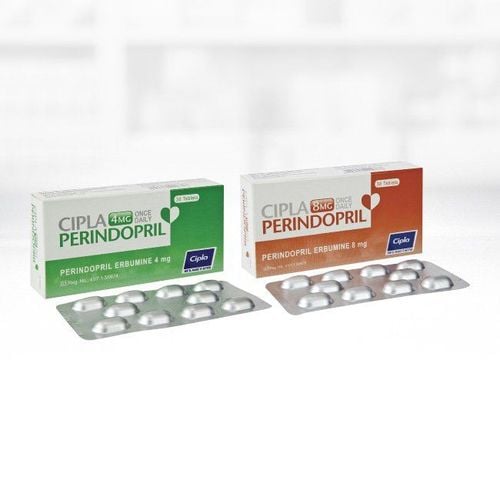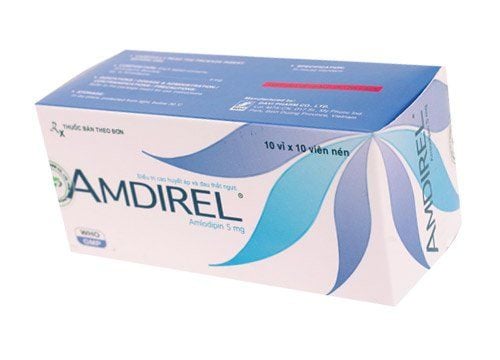This is an automatically translated article.
Calcium channel blockers are a group of drugs used to treat hypertension and angina pectoris widely used in clinical practice. The most common of which is the active ingredient Amlodipine with the commercial product Aldan. So how does Aldan drug work and what should be noted when using this drug?
1. What is Aldan?
Aldan drug is manufactured by Polfarmex S.A (Poland), prepared in tablet form for oral use and packed in a box of 3 blisters x 10 tablets.
Aldan's ingredients are the active ingredient Amlodipine 10mg. This product is circulated in Vietnam with registration number VN-15792-12 by Viet Phuong Medical Joint Stock Company.
2. Pharmacological characteristics of the drug Aldan
2.1. Pharmacodynamics The main active ingredient of Aldan is Amlodipine, which is a Dihydropyridine (DHP) calcium ion transporter. Aldan inhibits the influx of calcium ions across the membranes of cardiac muscle cells and smooth muscle cells on the wall of blood vessels by inhibiting the slow calcium channels of the cell membrane. Thanks to the effect of Aldan, smooth muscle tone in blood vessels (specifically the arterioles) decreases, thereby reducing peripheral resistance and leading to hypotension. Aldan also has anti-anginal effects mainly thanks to its ability to dilate peripheral arterioles and reduce afterload for the heart. At the same time, the level of energy consumption and oxygen demand of the myocardium are also reduced because the drug does not cause reflex tachycardia. Some theories suggest that Aldan also acts to dilate coronary vessels (including the great arteries and arterioles), both in the normal and ischemic myocardium. It is this direct coronary vasodilation that increases myocardial oxygen delivery and helps relieve angina.
2.2. Pharmacokinetics After using Aldan, the active ingredient Amlodipine is slowly and almost completely absorbed from the gastrointestinal tract. Absorption Aldan is not affected by food. Peak plasma concentrations of Amlodipine are achieved 6-12 hours after oral administration of Aldan and oral bioavailability ranges from 64-80%. The volume of distribution of Aldan is about 20 l/kg.
Amlodipine in Aldan binds to plasma proteins at a fairly high rate, about 95-98%. In the liver, Aldan is mainly metabolized to inactive metabolites. Approximately 10% of the active metabolites are not metabolized and 60% of the inactive metabolites are excreted in the urine. Elimination of Aldan is biphasic with a mean terminal half-life of about 35-50 hours. It should be noted that the steady state plasma concentration of Aldan is reached after 7-8 days of continuous use.
Aldan drug is well absorbed after oral administration, so the distribution of Amlodipine is very wide in the body. However, due to the slow elimination process, Aldan has a long-lasting effect, so it is suitable for once-daily use.
Patients with hypertension receiving Amlodipine once daily were able to maintain clinically meaningful blood pressure control for more than 24 hours in both the supine and standing positions. The antihypertensive effect of Aldan appears to be slow, so it is not suitable for patients who need rapid lowering of blood pressure.
In coronary artery disease, Aldan increases the patient's exercise capacity, reduces the frequency of angina attacks and reduces the need for nitrates.
Another advantage of Aldan is that it has no harmful effects on metabolism, does not affect plasma lipids and can be used in patients with bronchial asthma, diabetes and gout.
3. Indications and contraindications of Aldan
Aldan is indicated for use in the following cases:
As monotherapy in the treatment of hypertension, or in combination with other antihypertensive drugs if necessary (such as thiazide diuretics, beta-blockers) , ACE inhibitors or angiotensin II receptor blockers); Treatment of ischemic heart disease, stable angina or coronary spasm (Prinzmeta l angina). Note that Aldan can be used alone or in combination with other antianginal agents, or used in patients who are intolerant of nitrates and/or beta-blockers. Besides, the drug Aldan still has contraindications for use, including:
Patients with a history of hypersensitivity to the active ingredient Amlodipine, other Dihydropyridine derivatives or allergy to the excipients contained in the drug Aldan; Patients who are pregnant or breastfeeding should not take Aldan.
4. Dosage and how to use Aldan
Adults using Aldan for angina and hypertension: It is recommended to start with 5 mg orally once daily (1⁄2 Aldan 10 tablets), then adjust according to clinical response. available with a maximum dose of 10mg/day (1 tablet of Aldan 10); Patients with liver failure need to use Aldan at a lower dose; In particular, there is no need to adjust the dose of Aldan when combined with other drugs such as thiazide diuretics or ACE inhibitors.
5. Side effects of the drug Aldan
Amlodipine is well tolerated. In controlled clinical studies in patients with hypertension or angina treated with Aldan, the most common adverse events were:
Headache; Leg edema; Fatigue, drowsiness; Nausea, abdominal pain; flushing; Nervous; Dizzy. At the same time, these clinical studies did not show clinically significant changes in routine laboratory tests as a result of Aldan administration.
During treatment with Aldan, in addition to the common side effects mentioned above, patients may also experience some other adverse effects such as:
Digestive disorders, indigestion; Joint pain, muscle pain; Attenuate; Shortness of breath; Increased profit margin; gynecomastia or impotence; Frequent urination; Change in temperament; Itching, red skin rash; Visual disturbances; Rarely, erythema multiforme may occur; Aldan very rarely causes jaundice, mainly due to cholestasis or increased liver enzymes. Some cases of this effect required hospitalization, but the correlation with Aldan use is unlikely. Like other calcium channel blockers, Aldan very rarely causes the following serious side effects and is mostly indistinguishable from the underlying disease of the user: Myocardial infarction; Arrhythmia (ventricular tachycardia, atrial fibrillation); Chest pain.
6. Aldan Drug Interactions
Non-Steroidal Anti-Inflammatory Drugs (NSAIDs): Studies have shown that Aldan can be used safely in combination with non-steroidal anti-inflammatory drugs. However, the effectiveness of Amlodipine in controlling blood pressure may be reduced, especially when given concomitantly with Indomethacin due to inhibition of renal prostaglandin synthesis and/or salt and water retention; Estrogen causes water retention, so there is a tendency to increase blood pressure, which when combined can reduce the effect of Aldan drug; Sympathomimetic agents will reduce the antihypertensive effect of Aldan. Aldan medicine has the main active ingredient Amlodipine 10mg. The drug is used to treat high blood pressure and angina attacks. To ensure the effectiveness of treatment and avoid unwanted side effects, patients need to strictly follow the instructions of the doctor, professional pharmacist.
Follow Vinmec International General Hospital website to get more health, nutrition and beauty information to protect the health of yourself and your loved ones in your family.
Please dial HOTLINE for more information or register for an appointment HERE. Download MyVinmec app to make appointments faster and to manage your bookings easily.













